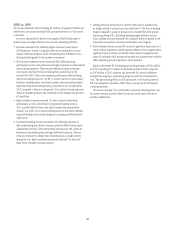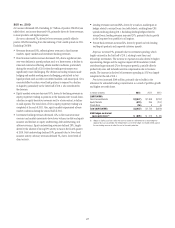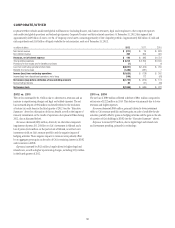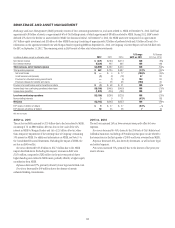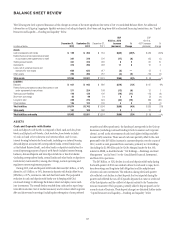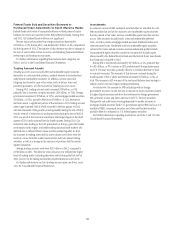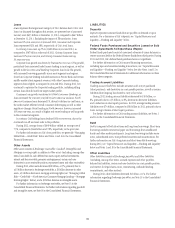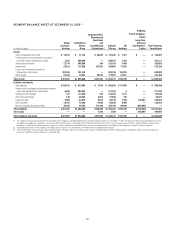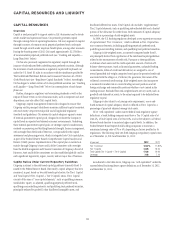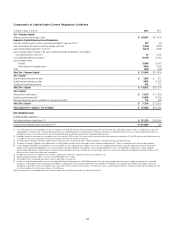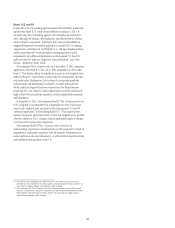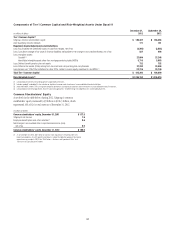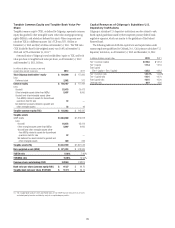Citibank 2012 Annual Report Download - page 57
Download and view the complete annual report
Please find page 57 of the 2012 Citibank annual report below. You can navigate through the pages in the report by either clicking on the pages listed below, or by using the keyword search tool below to find specific information within the annual report.35
Japan Consumer Finance
Citi continues to actively monitor various aspects of its Japan Consumer
Finance business, including customer defaults, refund claims and litigation,
as well as financial, legislative, regulatory, judicial and other political
developments, relating to the charging of “gray zone” interest. Gray zone
interest represents interest at rates that are legal but for which claims may
not be enforceable. In 2008, Citi decided to exit its Japan Consumer Finance
business and has liquidated approximately 85% of the portfolio since that
time. As of December 31, 2012, Citi’s Japan Consumer Finance business
had approximately $709 million in outstanding loans that currently charge
or have previously charged interest rates in the gray zone, compared to
approximately $2.1 billion as of December 31, 2011. However, Citi could also
be subject to refund claims on previously outstanding loans that charged
gray zone interest and thus could be subject to losses on loans in excess of
these amounts.
During 2012, LCL recorded a net decrease in its reserves related to
customer refunds in the Japan Consumer Finance business of approximately
$117 million (pretax) compared to an increase in reserves of approximately
$119 million (pretax) in 2011. At December 31, 2012, Citi’s reserves
related to customer refunds in the Japan Consumer Finance business were
approximately $736 million. Although Citi recorded a net decrease in its
reserves in 2012, the charging of gray zone interest continues to be a focus
in Japan. Regulators in Japan have stated that they are planning to submit
legislation to establish a framework for collective legal action proceedings.
If such legislation is passed and implemented, it could potentially introduce
a more accessible procedure for current and former customers to pursue
refund claims.
Citi continues to monitor and evaluate these developments and the
potential impact to both currently and previously outstanding loans in this
business and its reserves related thereto. The potential amount of losses and
their impact on Citi is subject to significant uncertainty and continues to be
difficult to predict.
Payment Protection Insurance
The alleged misselling of PPI by financial institutions in the U.K. has
been, and continues to be, the subject of intense review and focus by U.K.
regulators, particularly the Financial Services Authority (FSA). The FSA has
found certain problems across the industry with how these products were
sold, including customers not realizing that the cost of PPI premiums was
being added to their loan or PPI being unsuitable for the customer.
PPI is designed to cover a customer’s loan repayments if certain events
occur, such as long-term illness or unemployment. Prior to 2008, certain of
Citi’s U.K. consumer finance businesses, primarily CitiFinancial Europe plc
and Canada Square Operations Ltd (formerly Egg Banking plc), engaged in
the sale of PPI. While Citi has sold a significant portion of these businesses,
and the remaining businesses are in the process of wind down, Citi generally
remains subject to customer complaints for, and retains the potential liability
relating to, the sale of PPI by these businesses.
In 2011, the FSA required all firms engaged in the sale of PPI in the
U.K. to review their historical sales processes for PPI. In addition, the FSA
is requiring all such firms to contact proactively any customers who may
have been mis-sold PPI after January 2005 and invite them to have their
individual sale reviewed (Customer Contact Exercise).
Citi initiated a pilot Customer Contact Exercise during the third quarter
of 2012 and expects to initiate the full Customer Contact Exercise during the
first quarter of 2013; however, the timing and details of the Customer Contact
Exercise are subject to discussion and agreement with the FSA. While Citi
is not required to contact customers proactively for the sale of PPI prior to
January 2005, it is still subject to customer complaints for those sales.
During the third quarter of 2012, the FSA also requested that a number
of firms, including Citi, re-evaluate PPI customer complaints that were
reviewed and rejected prior to December 2010 to determine if, based on
the current regulations for the assessment of PPI complaints, customers
would have been entitled to redress (Customer Re-Evaluation Exercise). Citi
currently expects to complete the Customer Re-Evaluation Exercise by the
end of the first quarter of 2013.
Redress, whether as a result of customer complaints pursuant to or
outside of the required Customer Contact Exercise, or pursuant to the
Customer Re-Evaluation Exercise, generally involves the repayment of
premiums and the refund of all applicable contractual interest together with
compensatory interest of 8%. Citi estimates that the number of PPI policies
sold after January 2005 (across all applicable Citi businesses in the U.K.)
was approximately 417,000, for which premiums totaling approximately
$490 million were collected. As noted above, however, Citi also remains
subject to customer complaints on the sale of PPI prior to January 2005, and
thus it could be subject to customer complaints substantially higher than
this amount.
During 2012, Citi increased its PPI reserves by approximately $266 million
($175 million of which was recorded in LCL and $91 million of which was
recorded in Corporate/Other for discontinued operations). This amount
included a $148 million reserve increase in the fourth quarter of 2012
($57 million of which was recorded in LCL and $91 million of which was
recorded in Corporate/Other for discontinued operations). PPI claims paid
during 2012 totaled $181 million, which were charged against the reserve.
The increase in the reserves during 2012 was mainly due to a significant
increase in the level of customer complaints outside of the Customer Contact
Exercise, which Citi believes is largely as a result of the continued regulatory
focus and increased customer awareness of PPI issues across the industry.
The fourth quarter of 2012 reserve increase was also driven by a higher than
anticipated rate of response to the pilot Customer Contact Exercise, which Citi
believes was also likely due in part to the heightened awareness of PPI issues.
At December 31, 2012, Citi’s PPI reserve was $376 million.
While the number of customer complaints regarding the sale of PPI
significantly increased in 2012, and the number could continue to increase,
the potential losses and impact on Citi remain volatile and are subject to
significant uncertainty.



